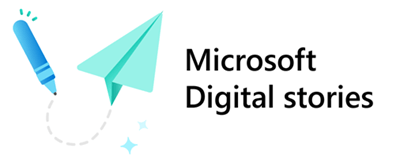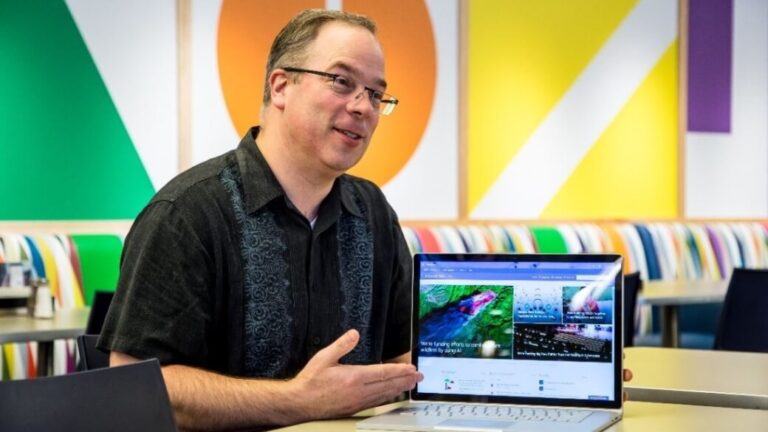
Editor’s note: This content was first published in 2022. Although this particular event or moment in time has passed, we’re republishing it here so you can see what our thinking and experience was like at the time.
Looking to find your benefits, adjust withholdings, or find a specific policy? Microsoft employees can get this information and more through HRWeb: our internal human resources site that serves as a central hub for a variety of important employment information.
As part of a company-wide push to improve the employee experience and meet employee needs around the globe, HRWeb is now supported by the modern experience in SharePoint. Along with being integrated into Microsoft 365, SharePoint has been optimized for a better user experience, including mobility.
“Through this migration, we improved the performance, accessibility, and reliability of our HRWeb platform while also reducing the cost to maintain it,” says Sam Crewdson, a principal program manager with Microsoft Digital, the company’s IT organization. “The platform, the way it’s built, it’s more what-you-see-is-what-you-get. It’s no longer complex.”
And this transformation is critical to empowering self-service at Microsoft. There’s no need to file a help desk ticket or to go looking for someone to help you when you can find what you need with a quick search.
“HRWeb is a critical asset for HR from a standpoint of supporting employees,” says Corinne Dubedat, HR director for Employee Support Experiences within HR Services. “We try to make sure employees are connected to resources in the best way possible so that they can spend their time focusing on their customers, effectively empowering the people who empower every person and organization on the planet to achieve more.”
With the modern platform in place, the company’s more than 220,000 employees can find the information they need in a snap, but it’s also easier for HR to manage content at scale. All of this translates into the kind of experience employees expect from Microsoft.
Save the best for last

Since 2016, Microsoft Digital has been migrating major functions across the company from classic to the modern experience in SharePoint. This Herculean effort has focused on moving over high-traffic portals—including corporate communications, IT, legal, and the corporate library—all without disturbing users.
“HRWeb has some unique needs that made us put it at the end of the list,” Crewdson says. “We needed it to be able to target by specific role, geography, and company code, otherwise users wouldn’t be able to easily find the right information.”
Because Microsoft has a presence in so many different countries and regions (it has subsidiaries in more than 120 countries and regions), it needs policies that reflect these different regulatory environments. Users on HRWeb should only see content that’s appropriate for their circumstances, which means a policy search should return information relevant to a specific user.
The same could be said of different roles, like what information a manager might have access to that an employee might not.
When you factor this across Microsoft’s large number of teams, vast global presence, and specific roles, the personalization requirements only compound.
But there was a vision for meeting HRWeb’s personalization needs.
Getting the fit just right
While most of the out-of-the-box functions within SharePoint would be an upgrade for HRWeb, including user targeting, Microsoft’s complicated global footprint would require some custom code.
Fortunately, the product was built for that.
“The SharePoint Framework empowers anyone to build for this platform,” Crewdson says. “A web developer can be a SharePoint developer as well.”
This meant that Microsoft Digital could work closely with the Employee Support Experiences team and product groups to get the solution exactly right for HRWeb’s needs.
“We saw the modern experience in SharePoint as the perfect landing place for us going forward from a user standpoint,” says Andy Hopkins, a software engineer with Microsoft Digital, who helped ready HRWeb for the move. “So when we went from classic to modern, we revamped how the content was tagged. It enabled us to be able to take information and make it available in more relevant locations for the users.”
This move opened up the ability to access content on HRWeb in a personalized and scalable way.
The shift was also an important part of Microsoft’s commitment to accessibility, with the modern SharePoint giving users everything they need to use and navigate the platform by default.
But Employee Support Experiences saw this migration as more than just a system upgrade.
An opportunity to hit the refresh button
It wasn’t just the backend that was changing for HRWeb. The transformation was extending to the content that employees would engage with as well.
“The move gave us an opportunity to align a few things while also getting the latest and greatest,” says Jodi Kogan, a senior manager of HR content and knowledge on the Employee Support Experiences team, who led the team responsible for the audit and the business requirements for the site redesign and migration. “We didn’t want to just do a lift and shift; we wanted to improve the experience for employees.”
Migrating to the modern experience in SharePoint meant the Employee Support Experiences team could perform an internal audit across all the content, develop new style guides, and simplify HRWeb, making it easier to navigate and search.
This meant getting rid of what didn’t make sense and ensuring content was going to the relevant persona.
“The features in the modern experience for SharePoint make it easier to do this. We’re able to personalize content better,” Kogan says. “We can also reuse content and tag things so that it shows up in the right places. This way we can surface content in a way that isn’t manual.”
Using Microsoft Entra ID to define groups and then tags to define content, the Employee Support Experiences team can ensure the right content showed up in the right country or region for the right role. And since content is centralized in SharePoint, it is easy to edit and then disseminate to appropriate users without oversharing.
A foundational experience to power the future of Microsoft
“If you’re spending a lot of time looking for something simple, that’s wasted time,” Dubedat says. “We don’t want to make people hunt through content. Eventually, we want to envision a world where we remove the need to even go to HRWeb, because the information can be found from anywhere.”
Integration with Microsoft Search, made possible by the move to the modern experience in SharePoint, is one of the initial efforts to seamlessly connect employees to HRWeb’s content. The content audit and migration are also empowering advisors and a virtual assistant, enabling stakeholders to find the right information faster.
Part of that is due to the new tags and personalization features, but it’s also due to improved performance.

“We reduced the number of server calls by around two-thirds,” Crewdson says. “We think we can get it down even more, which makes HRWeb faster, less expensive, and perform better. End users get a faster and better HRWeb, and we have something that’s more reliable and scalable.”
Now that a new backend platform is in place, the Employee Support Experiences team is working on introducing further improvements to the content that lives on HRWeb. This includes even more personalization for employees.
“Everything has a new look and feel, and the feedback has been favorable,” Kogan says. “We want to do even more to improve the UX and reduce the number of touchpoints.”
And these new features? They’re possible because HRWeb is now on the modern experience in SharePoint.
“What started out as being just a lift and shift ultimately ended up adding some new interesting features,” Hopkins says. “The SharePoint Framework really exposes the ability to create components with some basic standard web development tools. That’s a huge benefit to the end user and administrator.”

- The modern experience in SharePoint covers most of your intranet feature requirements out of the box, including mobile responsiveness. The SharePoint Framework enables developers who are familiar with common tools to integrate custom solutions with ease.
- Content owners can publish directly inside SharePoint, freeing up other team members to take on other roles.
- A good intranet reduces the number of steps it takes to find information. Integration with other Microsoft 365 tools, like Microsoft Search, puts information into the hands of users faster and from anywhere.
- Using groups in Microsoft Entra ID along with tags targets content to specific profiles. This enables scaling and personalization without having to republish content to multiple different locations.

Want to implement the modern experience of SharePoint at your own organization? Go here to learn more about the modern experience in SharePoint.






